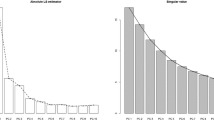Abstract
Regularization is a solution for the problem of unstable estimation of covariance matrix with a small sample set in Gaussian classifier. In many applications such as image restoration, sparse representation, we have to deal with multi-regularization parameters problem. In this paper, the case of covariance matrix estimation with multi-regularization parameters is investigated, and an estimate method called as KLIM_L is derived theoretically based on Minimum Description Length (MDL) principle for the small sample size problem with high dimension setting. KLIM_L estimator can be regarded as a generalization of KLIM estimator in which local difference in each dimension is considered. Under the framework of MDL principle, a selection method of multi-regularization parameters is also developed based on the minimization of the Kullback-Leibler information measure, which is simply and directly estimated by point estimation under the approximation of two-order Taylor expansion. The computational cost to estimate multi-regularization parameters with KLIM_L method is less than those with RDA (Regularized Discriminant Analysis) and LOOC (leave-one-out covariance matrix estimate) in which cross validation technique is adopted. Experiments show that higher classification accuracy can be achieved by using the proposed KLIM_L estimator.
Similar content being viewed by others
Notes
In this paper, KLIM is used to stand for an estimation method.
References
Bishop CM (2007) Pattern recognition and machine learning. Springer, New York
Everitt BS, Hand D (1981) Finite mixture distributions. Chapman and Hall, London
McLachlan GJ, Basford KE (1988) Mixture models: inference and applications to clustering. Dekker, New York
Jolliffe IT (1996) Principal component analysis. Springer, New York
Friedman JH (1989) Regularized discriminant analysis. J Am Stat Assoc 84(405):165–175
Hoffbeck JP, Landgrebe DA (1996) Covariance matrix estimation and classification with limited training data. IEEE Trans Pattern Anal Mach Intell 18(7):763–767
Srivastava S, Gupta MR, Frigyik BA (2007) Bayesian quadratic discriminant analysis. J Mach Learn Res 8:1277–1305
Friedman J, Hastie T, Tibshirani R (2008) Sparse inverse covariance estimation with the graphical lasso. Biostatistics 9(3):432–441
Daniels MJ, Kass RE (2001) Shrinkage estimators for covariance matrices. Biometrics 57(4):1173–1184
Ledoit O, Wolf M (2004) A well-conditioned estimator for large-dimensional covariance matrices. J Multivar Anal 88(2):365–411
Schafer J, Strimmer K (2005) A shrinkage approach to large-scale covariance matrix estimation and implications for functional genomics. Stat Appl Genet Mol Biol 4(1):1–28
Kuo BC, Landgrebe DA (2002) A covariance estimator for small sample size classification problems and its application to feature extraction. IEEE Trans Geosci Remote Sens 40(4):814–819
Bickel PJ, Levina E (2008) Regularized estimation of large covariance matrices. Ann Stat 36(1):199–227
Cao G, Bouman C, Webb K (2009) Noniterative map reconstruction using sparse matrix representations. IEEE Trans Image Process 18(9):2085–2099
Cao G, Bachega LR, Bouman CA (2011) The sparse matrix transform for covariance estimation and analysis of high dimensional signals. IEEE Trans Image Process 20(3):625–640
Rivals I, Personnaz L (1999) On cross validation for model selection. Neural Comput 11:863–870
Guo P, Jia Y, Lyu MR (2008) A study of regularized Gaussian classifier in high-dimension small sample set case based on MDL principle with application to spectrum recognition. Pattern Recognit 41:2842–2854
Redner RA, Walker HF (1984) Mixture densities, maximum likelihood and the EM algorithm. SIAM Rev 26:195–239
Aeberhard S, Coomans D, Vel DO (1994) Comparative analysis of statistical pattern recognition methods in high dimensional settings. Pattern Recognit 27(8):1065–1077
Rissanen J (1978) Modeling by shortest data description. Automatica 14:465–471
Barron A, Rissanen J, Yu B (1998) The minimum description length principle in coding and modelling. IEEE Trans Inf Theory 44(6):2743–2760
Kullback S (1959) Information theory and statistics. Wiley, New York
Webb AR (1994) Statistical pattern recognition. Oxford University Press, London
Nene SA, Nayar SK, Murase H (1996) Columbia Object Image Library (COIL-20). Technical report CUCS-005-96
Frank A, Asuncion A (2010) UCI Machine Learning Repository. http://archive.ics.uci.edu/ml. Irvine, CA: University of California, School of Information and Computer Science
Acknowledgments
The research work described in this paper was fully supported by the grants from the National Natural Science Foundation of China (Project No. 90820010, 60911130513). Prof. Guo is the author to whom the correspondence should be addressed, his e-mail address is pguo@ieee.org.
Author information
Authors and Affiliations
Corresponding author
Rights and permissions
About this article
Cite this article
Zhou, X., Guo, P. & Chen, C.L.P. Covariance Matrix Estimation with Multi-Regularization Parameters based on MDL Principle. Neural Process Lett 38, 227–238 (2013). https://doi.org/10.1007/s11063-012-9272-7
Published:
Issue Date:
DOI: https://doi.org/10.1007/s11063-012-9272-7




